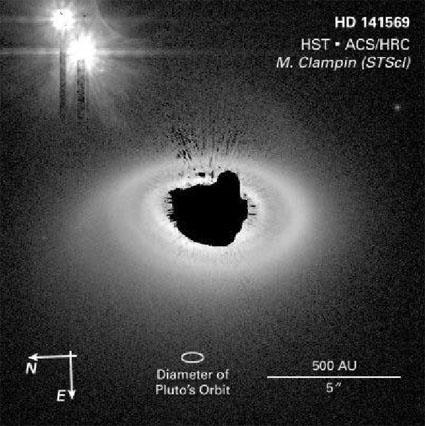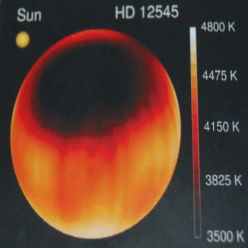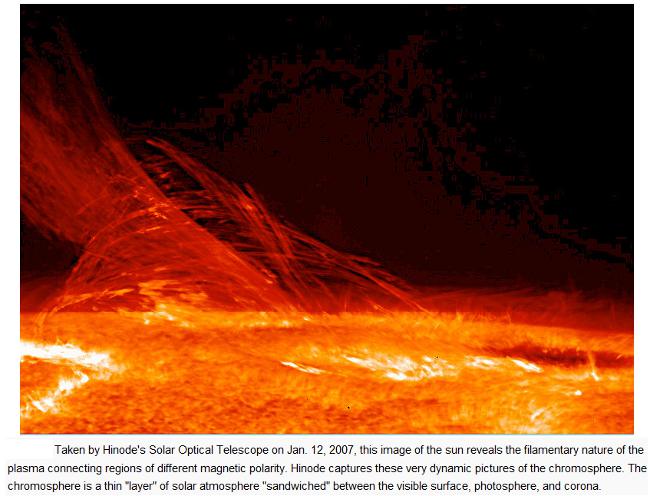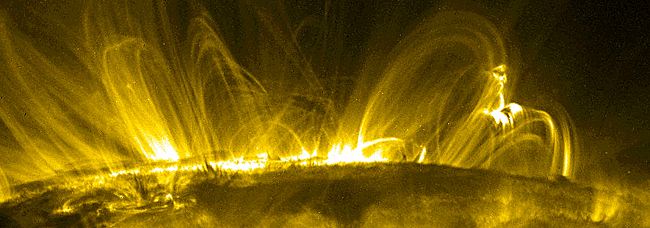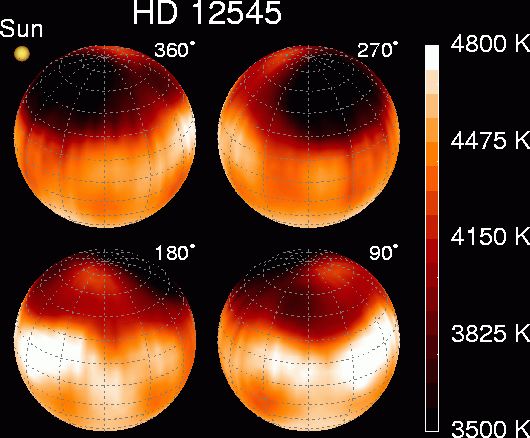List members , if we really , truly want to understand how stars , planets and moons formed in our own Solar system , we need to take a journey far back in time...to 4.5 billion years ago - long , long ago , in a galaxy , far , far away - actually I mean our very own
Milky Way...! :))
Now this article I am posting is a masterpiece from Wal Thornhill , one of the shining stars of the Electric Universe theory - this is not an easy read , but I assure you , if you manage to get to the end of it , the effort would seem worthwhile . Wal Thornhill is indeed a worthy successor to Immanuel Velikovsky , the father of Electric Universe theory.
Some of the highlights of this article :
-
In the Plasma/Electric Universe framework , gas giant planets are electrically ejected from the parent sun , whereas the rocky planets like Earth , Venus are electrically ejected from the gas giant planets ! There are legends of the Earth having started out as a moon of Saturn that evolved into an independent planet...there are traditions that regard Venus as having started out as an electrical comet...
-
The Plasma Universe theory gives a satisfactory explanation for elliptical orbit of planets , eccentric orbits of planets as also the proximity of gas giants to their parent stars in many other Solar systems
-
The abnormally large gas giant planets orbiting very close to their not so big parent stars in many other solar systems can again , be properly explained by Plasma/Electric Universe theory
Planet Birthing
May 25th, 2003 Wal Thornhill EU Views
Dan Falk prefaced a recent news report in Nature, on the subject of planet formation, with these words:
“Our knowledge of planets outside our Solar System has been transformed in the past few years. But these new-found worlds don’t look much like our planetary neighbours, and no one is quite sure why.”
At a rough glance the traditional nebular disk model used to explain the formation of planets in our solar system seems plausible. After all, the orbits of the planets do describe a thick disk about the Sun. But could this model be wrong? It requires that the planetary orbits be in the same plane. Instead we find them tilted at substantial angles to the Sun’s equator. Now that new discoveries challenge our cherished notions it is time to revisit the basic questions:
Are planets formed slowly by accretion over millions of years or “born” suddenly and violently from a larger body? Does the solar system have a more complex history?
The likelihood is extremely high that planets do not form slowly. The accretion disk model is riddled with assumptions about initial conditions and glosses over many problems that have remained stubbornly unsolved. For example, there are severe problems in getting a rotating nebula to collapse gravitationally to form a star in the first place. The large rotational momentum of a cosmic nebula has somehow to be dissipated. And an embedded magnetic field conspires to prevent collapse. The Nobel Prize winner, the late Hannes Alfvén, wrote in Evolution of the Solar System, “..the ‘generally accepted’ theory of stellar formation may be one of a hundred unsupported dogmas which constitute a large part of present-day astrophysics.”
The protoplanetary disk model assumes that the planets were formed largely where we find them now. That seems not to be true. Long-term computer integrations of physically different models of the solar system show chaotic behavior (that can mean planets being thrown out of the solar system) in an interval of 3 to 30 million years – a blink of the eye in the accepted age of the system. The authors of one study described this result as “very striking and disturbing.” (Chaotic Evolution of the Solar System, Sussman & Wisdom, Science, Vol. 257, 3 July 1992, pp. 56-62). If this is so we cannot use the present plan of the solar system to say anything about the initial plan or its evolution.
The protoplanetary disk model also assumes that planets can accrete by collisions of particles in the disk. A recent study of hyper-velocity impacts between small objects, which assumes very different orbits of those particles, showed that the crater formed was larger than the impactor with the result that fragmentation rather than accretion is the rule. Also, objects in similar orbits about a central mass merely swap places without colliding. For example, two moons of Saturn, Epimetheus and Janus, swap orbits every 4 years or so. These problems have resulted in a spate of additional ad hoc requirements to be added to computer models. For example, the matter in the disk must have been hot and “squidgy” to allow particles to stick together.
In fact, the very term “accretion disk” used by computer modellers begs the question about the origin of such disks observed elsewhere in the galaxy. When we see objects with strong gravitational fields ejecting huge masses of material at great speeds we must consider the possibility that we are observing “expulsion” disks. After all, it is not clear what is responsible for energetic expulsions if we are looking at systems governed solely by gravity. Explanations based upon magically conjured and trapped magnetic fields merely shove the problem out of sight within the central star or hypothetical black hole. And without exception they ignore the electrical origin of magnetic fields.
When it comes to detailed examination of the planets, theories go from bad to worse. No plausible model exists to explain the fruit salad of characteristics we find. A good theory should explain the obvious dichotomy between the rocky planets and the gas giants without requiring more ad hoc early conditions. It must explain the odd axial tilts of the planets. After all, they behave as giant gyroscopes whose spin axes will merely wobble when struck by another sizeable object. We should expect the giant planets to have their equators in the plane of the ecliptic but we have Saturn tipped over by 27 degrees and Uranus by 98 degrees!
If we are ever to be satisfied that we understand the basic principles of planet formation we must include all of the information available to us from human observations of the sky. As Alfvén wrote,:
“Because no one can know a priori what happened four to five billion years ago, we must start from the present state of the solar system and, step by step, reconstruct increasingly older periods. This actualistic principle, which emphasizes reliance on observed phenomena, is the basis for the modern approach to the geological evolution of the Earth; ‘the present is the key to the past.’ This principle should also be used in the study of the solar system.”
Even in this wise advice there is an assumption that the sky we see today is the same as that seen by our prehistoric ancestors. Recent forensic examinations of astronomical petroglyphs and global creation myths argue strongly against such a cosy assumption. The present may not be the key to the past. It should be remembered that theories of evolution, both geological and biological, are easily demonstrated by their effects but remain without plausible causes. We have progressed to the point of accepting the possibility of cosmic impacts but even they cannot explain all of the evidence. Perhaps there is a common mechanism for evolution on Earth that includes evolution of the solar system? Perhaps the solar system has a recent history? If so, attempts to explain the solar system by modelling theoretical initial conditions based on modern observations must fail.
It is worth highlighting some of the unconscious assumptions with reference to Falk’s report, which follows in part. The ELECTRIC UNIVERSE® alternative will be outlined to give an impression of its relative simplicity.
Planet formation: Worlds apart
(Nature 422, 659 – 660, 2003)
Cloudy picture: computer simulations have yet to nail down the finer points of planetary evolution. L. Mayer, T. Quinn, J. Wadsley, J. Stadel/Pittsburgh Supercomp. Cen.
Comment: This remark is disingenuous and demonstrates a disturbing trend to believe that computer “game playing” can reveal the truth of a theory. Even the evolution of the gross characteristics of the solar system remains to be “nailed down.” Computer simulations can only help to eliminate some models if all of the variables are known. But that is practically never the case in complex, real-world situations.
Less than a decade ago, planetary scientists were working with a tiny data set: the nine members of our Solar System. But the past few years have been a boom time for planet hunters — more than 100 planets orbiting other stars have now been logged. As new detection methods come into use, this tally is certain to climb higher.
Not everyone is celebrating, however. Extrasolar planets have peculiar properties, and our understanding of how planets form, which was incomplete even before the new data became available, now looks even shakier. The newly discovered bodies have strange, highly elliptical orbits. They are also far closer to their stars than equivalent planets in our Solar System. Amid the thrill of discovery, planetary scientists are wondering how to make sense of the processes that shaped these strange new worlds.
In terms of mass, the new planets are similar to Jupiter, weighing between one-tenth and ten times as much — the majority fall between 0.75 and 3.0 jovian masses. Measuring size is more difficult, as only transit studies can provide information on the object’s radius. The planet observed using the transit method — an object orbiting a star in the constellation of Pegasus— is slightly larger than Jupiter.
But that’s where the similarities end. The orbits of most extrasolar planets follow elliptical paths, in contrast to the near-circular orbits of our Solar System’s giant planets. They also orbit much closer to their parent stars, most at a distance of less than 2 astronomical units (1 AU being the distance between Earth and the Sun), compared with more than 5 AU for Jupiter.
It is these properties that seem to defy popular models of planetary formation. The two main theories each start with a slowly spinning ball of gas. The hot, central part becomes a star, while the material farther out is flattened by its rotation into a cloud known as a protoplanetary accretion disk. This provides the raw materials from which planets form.
Comment: Here are two fundamental assumptions that drive all current models of stellar and planet genesis. The first is that stars form simply by gravitation from a rotating “accretion disk” of neutral matter. The second is that planets accrete later from the widely scattered leftovers. Both processes have theoretical difficulties and are the most inefficient imaginable – only 1% of the proposed nebula “leftovers” remains in the planets. Neither process has been observed in action, merely inferred.
The idea of what goes on inside a star stems from the work of Sir Arthur Eddington in his famous 1926 work, The Internal Constitution of Stars. He made a serious error of judgement when he applied mechanical ideal gas laws to the Sun’s interior. On that basis he calculated that there would be “no appreciable separation of the [electrical] charges.” It was a convenient conclusion because it simplifies the standard solar model so that it is “do-able.” It seems not to have been questioned since.
In fact, atoms in the Sun’s strong gravitational field will distort to form small electric dipoles, with the positive nucleus offset within each atom toward the center of the Sun. The aligned dipoles will create a radial electric field that will tend to separate charge – free electrons moving toward the surface and positive ions toward the core. Gravitational compression inside the Sun is therefore offset by electrical expansion because like charges repel. Stars do not require a central furnace to maintain their size. The result is that the Sun is much the same density throughout. This was discovered decades ago by pioneering helioseismologists but not announced because it was believed that eventually a more acceptable explanation would be found in terms of the standard model! The enigma remains to this day. To accept the obvious conclusion would destroy the elaborate story of the evolution and death of stars. And another source of stellar energy would be required because nuclear fusion would be impossible in the core of an isodense star. Ah well, that’s the price of progress.
However, it is acknowledged that stars can explode in a nova or supernova event because such things are regularly observed. But the explosion mechanism remains obscure. An explosion originating in the core was always expected to be spherically symmetric. But we observe stellar explosions to be highly directional, often forming bipolar cones or even collimated jets. Plasma physicsts are well aware that powerful electric discharges form thin jets, often with condensations/knots of matter along them. And a collimated jet is a prime requirement for the birth of a planet from a star. Significantly, the light curve from stellar explosions is the same as that of lightning.
There is a more simple and efficient process that fits the latest discoveries. It requires the expulsion, or “birth” of a fully formed proto-planet from the core of a star or gas giant. Astrophysicists have not seriously considered it because of their strongly held views about the internal nature of stars and the forces at work there.
HD 141569A is a five-million-year-old star 320 light-years away in the constellation Libra. Hubble's Advanced Camera for Surveys captured this visible-light image on July 21, 2002, with a coronagraph, which blocked light from the star, creating the black area in the center. Surrounding the star is a tightly wound spiral-structured dust disk with two faint arms in the outer part of the disk. One of these arms reaches toward a binary star inthe upper left of the image. NASA / M. Clampin (STScI) et al. / ACS Science Team / ESA
This is the best image of a so-called accretion disk. It was produced on January 6 by a team headed by Mark Clampin of the Space Telescope Science Institute. The disk contains a tight spiral structure with two diffuse arms reaching outward like those of a spiral galaxy. It is excellent evidence for the electrical discharge nature of these disks since plasma physicists have successfully modelled galaxy formation and produced the classic spiral formation. That modelling requires electric currents flowing along the spiral arms. Notably it doesn’t require invisible dark matter!
The physicist, Peter Warlow, made the colorful comment in 1982 that we assume that planets are formed outside stars “for the ‘obvious’ reason – that’s where we find them.” However, “We humans, equally ‘obviously,’ are outside our mothers – yet we did not start there!” It is far simpler and infinitely more efficient if planets are “born” at intervals by the electrical ejection of charged material from the similarly charged interiors of larger bodies – gas giants from stars, and rocky planets from gas giants. We have circumstantial evidence for such a proposal in the binary stars found after a nova outburst. Also most of the rocky bodies in the solar system closely orbit a gas giant. Electrical ejection in a massive internal lightning flash answers the question of the source of the energy. It is not dispersive like an explosion. The electromagnetic pinch effect will produce a jet of matter, rather like a coronal mass ejection, only on a much grander scale. The result is a proto-planet plus a stream of gases and meteoric debris.
The electrical expulsion model solves the many riddles of meteorites. They are the afterbirth of a new planet, not a star. What is the origin of tiny melted spheres of silica, called chondrules, found in many meteorites? How were they flash-heated and just as suddenly cooled? How did radioactive isotopes with half-lives measured in hours and days become trapped in meteorites? A powerful cosmic electric discharge provides simple answers. Astrophysicists in the past have suggested lightning in the accretion disk as an explanation for chondrules, but without understanding what causes lightning the idea died. The May 17 issue of New Scientist reports a new idea from astrophysicist Frank Shu. He argues that meteorites were formed in “furious winds that blew red-hot rock out from the Sun at hundreds of kilometres per second.” Lightning creates just such “furious winds” of heated matter along the discharge channel. Shu’s explanation, on the other hand, suffers the usual lack of understanding of plasma electrical behavior and relies, once more, on magnetic fields to perform the necessary miracles.
Falk’s report notes that extrasolar giant planets are too close to their stars to have formed there from a protoplanetary accretion disk. Rather than question the protoplanetary accretion disk model, the obvious proposal is to have the giant planets migrate after their formation elsewhere. However, it does not explain the orbital eccentricities. In our solar system, Uranus and Neptune are too far from the Sun to have formed where we find them. Why have our giant planets seemingly migrated outward and the extrasolar planets inward? When theoretical expectations fail scientists are required to re-examine all of the assumptions in their models. However, that is not done when some assumptions have become self-evident truths.
Rocky start
From there on, the process is open to debate, with the answer partly depending on the size of the disk. The core-accretion model, which dates from the 1960s, argues that planets start life as small chunks of rock, dust and sand-grain-sized debris that come together through collisions. As the rocky core grows, its gravitational pull scoops up more dust and gas from the disk. If the core is heavier than a few Earth masses, it accretes enough gas over a few million years to become a gas giant like Jupiter and Saturn. Less-massive cores result in rocky planets like Earth.
This model ran into problems even before extrasolar planets were identified. For one thing, it seems to take too long. Accretion disks are thought to evaporate within a million years or so, probably as a result of the stream of electrically charged particles that all stars emit, or of bombardment from high-energy ultraviolet photons from other nearby stars.
Comment: Here is an additional assumption. Having somehow gravitationally formed an accretion disk we must follow that with a special active stellar condition to blow it away after a convenient time interval. Studies have shown that the stellar wind would merely shift the disk further away and not disperse it. Alfvén argued that the most efficient (and Nature is nothing if not efficient) method to accrete matter over cosmic distances is that of the electromagnetic “pinch effect” caused by parallel electric current filaments in plasma. The electromagnetic accretion force diminishes slowly with distance from the filament axis, rather than rapidly with the square of the distance as we find with gravity. The result is condensed, rotating objects strung along the dusty current filaments. The spin axes of stars formed in this manner are aligned with the filaments. Such alignments have been discovered in groups of stars.
The main rival theory, which also surfaced in the 1960s, avoids this problem. Known as the disk-instability model, it proposes that, in larger disks, patches of denser gas can form and pull in more gas — leading, in some cases, to a sudden collapse that forms one or more planets. Such collapses do not occur in the core-accretion model, either because the disk is not large enough to produce them, or because any small instability that forms will tend to spread throughout the disk, restoring stability.
Planets are thought to form more rapidly in the disk-instability scenario. Last autumn, Lucio Mayer, a theoretical astronomer then at the University of Washington in Seattle, described high-resolution computer simulations of protoplanetary disks using the disk-instability model. Together with colleagues elsewhere in North America, Mayer showed that giant planets could form in as little as 1,000 years. The difference in planet-forming rates is probably the most important distinguishing characteristic between the two models, and is a boost for the disk-instability idea, says Alan Boss, a theoretical astrophysicist at the Carnegie Institution of Washington.
Others urge caution. Jack Lissauer, a planetary scientist at NASA’s Ames Research Center in Moffett Field, California, says that the resolution of the computer models is still too poor to give conclusive results. Perhaps more importantly, the new data on extrasolar planets do not sit happily with either theory. The models have trouble explaining, for example, why Jupiter-sized planets are created rather than brown dwarfs — objects that are intermediate in size between planets and stars. “You would expect the mass of planets to range from Jupiter mass up to stellar masses,” says Douglas Lin, an astrophysicist at the University of California, Santa Cruz. There ought to be just as many brown dwarfs as Jupiters orbiting Sun-like stars — something that observations have not turned up.
Comment: Computer simulations are fun but they have no significance if the models are wrong. The lack of brown dwarf stars is expected in the ELECTRIC UNIVERSE® model. In that model, stars are essentially a plasma discharge phenomenon. A bright star usurps almost the entire electrical power in its vicinity. Hypothetically, if Jupiter were to be removed beyond the Sun’s electrical influence it would become a more electrically active brown dwarf star. Its moons would become a small planetary system orbiting a dim star. The dull red shell, or “anode glow,” of a brown dwarf would surround most of the moons. The conditions for establishment of atmospheres and life on those satellites within the glowing shell would likely be fulfilled. Just like real estate, the prime requirement to become a star is LOCATION. A brown dwarf simply won’t shine when placed close to a bright star.
Unfortunately, astrophysicists and most plasma physicists never contemplate an electrically driven model because they assume strict electrical neutrality throughout the universe. Meanwhile the observational evidence shrieks of electric discharge effects in plasma. A few examples are: all X-ray sources; stupendously long glowing filaments and jets; radiant nebulae with no effective internal energy source; and compact pulsating radiation sources.
Inner workings
Other aspects of the new data are causing problems for both models. Neither, for example, accounts for the proximity of the extrasolar planets to their stars. There isn’t much material in the inner region of the disk, and the particles there should have enough energy to resist clumping. The solution, astronomers suggest, is that giant planets form farther out and then migrate inwards as a result of interactions between the disk and the planet. The mechanism differs in the two models, but the end result is that young planets sail through the disk towards the star.
But this raises another question: what stops the planet from ploughing into its parent star? Several mechanisms have been suggested. One option is that the migration ends when the disk evaporates — but it’s not clear whether this can happen quickly enough, as migration occurs on a roughly million-year time scale. Another option is that the planet’s gravitational pull distorts the shape of the star, and that this in turn affects the pull of the star on the planet in such a way as to balance the planet’s inward movement. Finally, it could be that the star’s magnetic field clears out the inner disk by repelling electrically charged particles. In this situation, says Boss, the inner 0.5 AU of the disk would be empty — and few extrasolar planets have orbital radii much smaller than this. “It’s attractively simple,” says Boss.
Comment: If that’s simple I would not like to see a complicated explanation! There comes a time when attempts should be abandoned to reverse-engineer a doubtful model of the solar system to fit data from other planetary systems. A far simpler explanation is that gas giant planets are born by electrical expulsion from a star in a nova outburst. How else should we expect to find an extrasolar planet whipping around its parent in a few days or in an eccentric orbit? Eccentric orbits should be short-lived. They hint at recent events in those distant planetary systems; perhaps the birth of a new planet. Perhaps clockwork planetary systems that endure unchanged for billions of years do not exist?
Such explanations are plausible, but there is no way of knowing which is correct. Even if this issue is resolved, it is still unclear whether planets form by disk instability or by core accretion before they begin their migration. And on top of that, astronomers are struggling to explain why so many extrasolar planets follow elliptical paths, as both formation models predict roughly circular orbits. The best explanation so far proposed is based on the gravitational tug-of-war between different planets in a multi-planet system.
Comment: The problems arise because an inappropriate gravitational model is used in both cases. Granted that a multi-planet system is inherently chaotic if gravity is the only force operating. But in an ELECTRIC UNIVERSE® there is a damping mechanism to limit wild excursions. It seems that exchange of charge between planets via their magnetotails (plasma sheaths) is capable of maintaining orbital spacing so as to limit further electrical interaction. This mechanism may provide a physical basis for Bode’s relationship. And a planet moving eccentrically in the weak electric field of a star suffers a cometary discharge that acts to reduce the eccentricity of its orbit. The effect has been noted for tiny solar comets and mysteriously termed a “non-gravitational” force. It is more effective than tidal interactions at circularising orbits.
Science rewrites Genesis
Present theories of the origin of the universe and the Earth have taken on the mantle of religious truth. It is as if scientists feel obliged to provide an alternative “scientific” Genesis story to replace the biblical one. All that has been achieved is a Hollywood rewrite complete with the obligatory stupendous explosion, an imaginary hell of black holes and the occasional miracle to allow the plot to continue. The story has been limited by cultural preconceptions and by restricting the “writers” to experts in one narrow specialty. The story is overdue for a shake-up. The irony is that Genesis is only one version among many of a major evolutionary event in the history of the solar system; a “re-creation” event witnessed by prehistoric man and memorialised by all of the earliest civilizations. It has much to offer in a more general approach to discovering the real history of the Earth and the origin of planets.
Meanwhile the astronomers’ script for Earth history is showing its age. It comes straight from the early Industrial Revolution – it is purely mechanical and clockwork-like with nary a hint of new-fangled electrics. Indeed there are no electric lights at all! Dissenting electrical engineers and plasma physicists have been practically ignored. It has fallen to the IEEE to establish a separate chapter of Plasma Cosmology, which now holds separate meetings.
It has not been felt necessary to check the fundamental assumption that ‘the present is the key to the past.’ No astronomer is qualified to do a forensic examination of the earliest planetary mythologies and depictions of the sky to see if that sky looks familiar. The fact is it doesn’t! That renders all of the comfortable armchair theorizing and computer simulations a nonsense. Mark Twain was right: “There is something fascinating about science. One gets such wholesale returns of conjecture out of such a trifling investment of fact.” Computer modelling is usually only possible with “a trifling investment of fact.”
The Prehistoric Sky
“A man receives only what he is ready to receive. . . . The phenomenon or fact that cannot in any wise be linked with the rest of what he has observed, he does not observe.”
– Henry D. Thoreau
Throughout the ancient world the star between the horns of a crescent was an important religious symbol. Yet it is physically impossible if the crescent represented the Moon. What is more, the apparition was universally reported to have occupied the top of a tapering column of light in the motionless center of the northern sky – the north celestial pole – where the Moon never goes. It was often pictured as a figure with arms stretching upwards.
The north celestial “pole” was commemorated by all ancient cultures as the home of the prehistoric sun and the planetary gods. A true history of the Earth must explain these astronomical enigmas. And a true history of the Earth is necessary before we can speculate meaningfully about planet origins.
“Like a man was the sun when it showed itself, and its face glowed when it dried the surface of the earth…It showed itself when it was born and remained fixed in the sky like a mirror. Certainly it was not the same sun which we see, it is said in their old tales.”
– D. Goetz & S. Morley, Popol Vuh, 1972, p. 188.
The detail (left) in these early renditions shows a raised central hemisphere in front of another radiating star-like body, superimposed upon a crescent.
The Bottom Line
The bottom line is that a better theory of the formation of planets requires the observational skills of astronomers, the forensic input of comparative mythologists, the theoretical input from plasma physicists and the practical experimental capabilities of electrical engineers. Most importantly, the common thread for this interdisciplinary approach is provided by the new paradigm of an ELECTRIC UNIVERSE®. But we should keep in mind that the odd natures of the planets in our solar system argue for a complex history that may never be entirely amenable to computer modelling. The orbital and axial tilts of the giant planets are strong evidence for one or more capture events. Perhaps we may be able to determine a planetary genealogy?
“It is possible that this new era also means a partial return to more understandable physics. For the nonspecialists, four-dimensional relativity tbeory and the indeterminism of atom structure have always been mystic and difficult to understand. I believe that it is easier to explain the 33 instabilities in plasma physics or the resonance structure of the solar system. The increased emphasis on the new fields means a certain demystification of physics. In the spiral or trochoidal motion which science makes during the centuries, its guiding center has returned to these regions from where it started. It was the wonders of the night sky, observed by Indians, Sumerians, or Egyptians, that started science several thousand years ago. It was the question why the wanderers – the planets – moved as they did that triggered off the scientific avalanche several hundred years ago. The same objects are now again in the center of science – only the questions we ask are different. We now ask how to go there, and we also ask how these bodies once were formed. And if the night sky on which we observe them is at a high latitude, outside this lecture hall – perhaps over a small island in the archipelago of Stockholm – we may also see in the sky an aurora, which is a cosmic plasma, reminding us of the time when our world was born out of plasma. Because in the beginning was the plasma.”
– H. Alfvén, Science 4 June 1971. From a lecture he delivered in Stockholm, Sweden, on 11 Dec 1970 when he received the Nobel Prize in Physics.
Wal Thornhill
Next
SETI – The Search for Extraterrestrial Intelligence »
Previous
« Squashed Star Flattens Solar Theory
Search
Recent Posts
- Wal Thornhill: SAFIRE and the Future of Science, Part Two | Space News
- Wal Thornhill: SAFIRE and the Future of Science, Part One | Space News
- Wal Thornhill: The Electric Asteroid Bennu | Space News
- Wal Thornhill: Big Bang Busted Again | Space News
- Electric Universe on Gaia Video Streaming
Archives
- 2019
- 2018
- 2017
- 2016
- 2015
- 2014
- 2013
- 2012
- 2011
- 2010
- 2009
- 2008
- 2007
- 2006
- 2005
- 2004
- 2003
- 2002
- 2001
- 2000
- 1999
©holoscience.com 1999 - 2018. Site by Smiffbuilt, Theme by Themesmob

